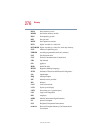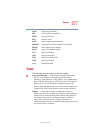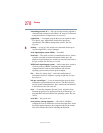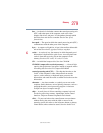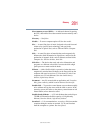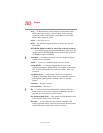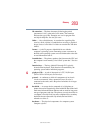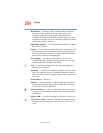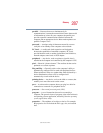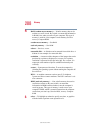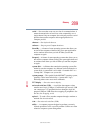
283
Glossary
5.375 x 8.375 ver 2.4.0
file extension — The three characters following the period
(pronounced “dot”) at the end of a file name. The extension
indicates the type of file. Examples are .exe for program files
and .hlp for help files. See also file name.
folder — Also called directory. A container for organizing files
saved to a disk. A folder is symbolized on screen by a graphical
image (icon) of a file folder. A folder can contain files and other
folders.
format — (verb) To prepare a blank disk for use with the
computer’s operating system. Formatting creates a structure on
the disk so the operating system can write information to the disk
or read information from it.
frontside bus — The primary pathway (bus) between the CPU and
the computer’s main memory. Also called “system bus.” See also
bus.
function keys — The keys labeled F1 through F12, typically
located on the keyboard. Their function is determined by the
operating system and/or individual programs.
G
gigabyte (GB) — A unit of data equal to 1,073,741,824 bytes
(1024 x 1024 x 1024 bytes). See also byte.
ground — A conductor to which all components of an electric
circuit are connected. It has a potential of zero (0) volts, is
connected to the earth, and is the point of reference for voltages
in the circuit.
H
hard disk — A storage device composed of a rigid platter or
platters that can be magnetically coded with data. Hard disks hold
much more information than diskettes and are used for long-term
storage of programs and data. The primary (or only) hard disk in
a computer is usually fixed, but some computers have secondary
hard disks that are removable. By default, the hard disk is
referred to as drive C.
hardware — The physical components of a computer system.
Compare software.




